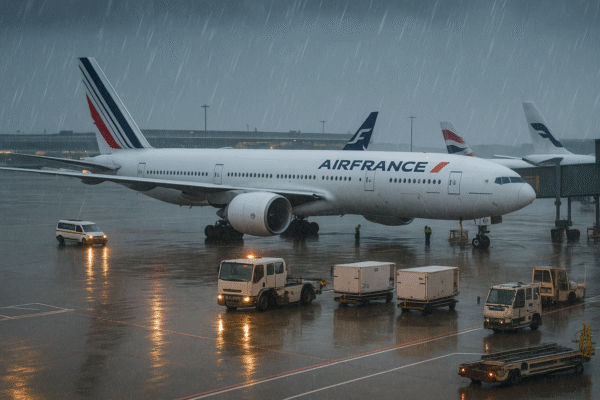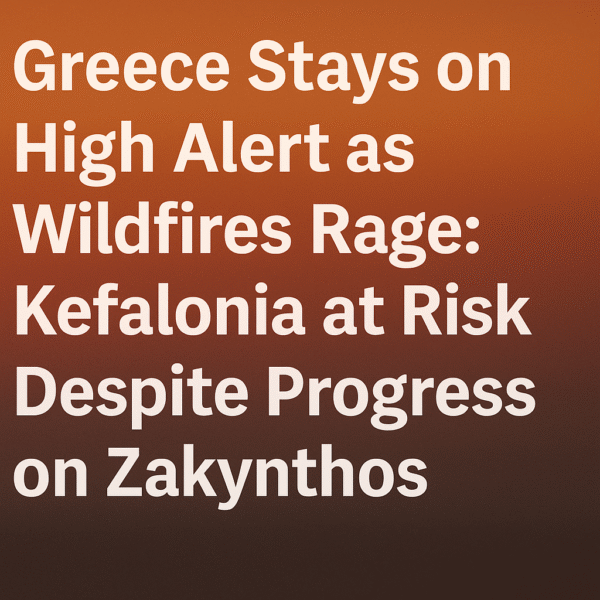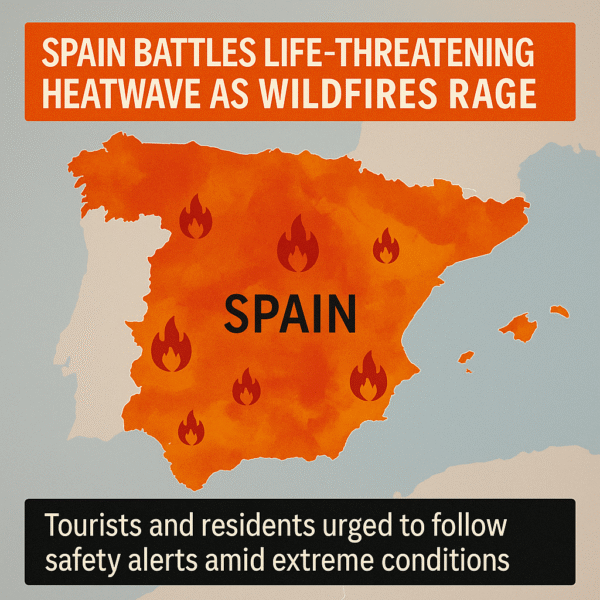Spain is currently grappling with one of its most dangerous summers in recent history as a record-breaking heatwave intensifies, sparking numerous wildfires and prompting emergency alerts across the nation. With temperatures soaring beyond 44°C (111°F) in some areas, the country’s national weather agency, AEMET, has issued extreme fire risk warnings in nearly all autonomous regions.
The heatwave, which began intensifying in early August 2025, is expected to persist through mid-August, with forecasters warning that relief is unlikely until early next week. The government and emergency services are urging both residents and tourists to remain vigilant and follow safety protocols.
Rising Temperatures Spark National Emergency
The Spanish Meteorological Agency has declared a red alert in several provinces, particularly across the Cantabrian and southern regions, due to persistent scorching temperatures combined with dry winds. This dangerous weather cocktail has led to explosive fire conditions, triggering mandatory evacuations in dozens of rural communities.
According to AEMET, Friday, August 15, marked the peak of the heatwave, with inland regions such as Castilla-La Mancha and Andalusia reaching temperatures of 44°C (111°F) and experiencing dangerously low humidity levels.
The Interior Ministry has activated national emergency protocols and reinforced firefighting efforts with support from the Military Emergency Unit (UME). Drones and helicopters have been deployed in remote regions to monitor fire activity and aid containment operations.
Wildfires Sweep Across Spain: Key Affected Areas
As of now, major wildfires have been reported in the following regions:
- Catalonia: A fire in Lleida has consumed over 2,000 hectares of land. Firefighters are working around the clock amid harsh wind conditions.
- Andalusia: The Sierra de Huelva region is battling multiple fires, with thousands of residents evacuated as flames threaten residential zones.
- Aragon: Emergency services have contained some blazes, but the region remains on high alert.
- Valencia: Fires have broken out in dry agricultural zones, with damage to local crops and wildlife habitats.
Despite efforts, firefighting teams face significant challenges due to unpredictable wind shifts, scorching heat, and limited water resources in arid regions.
Government Response and Safety Measures
The Spanish Ministry for the Ecological Transition has mobilized all available resources to combat the escalating wildfire situation. Coordination between local fire departments, Civil Protection, and regional governments is ongoing. Evacuation shelters have been opened in affected zones to support displaced residents and tourists.
In a press conference, Spain’s Prime Minister urged the public to cooperate with evacuation orders and avoid traveling to high-risk zones. The government also announced the potential deployment of international firefighting support if the crisis worsens.
Advice for Tourists Visiting Spain
With millions of tourists visiting Spain during August’s peak travel season, local authorities have issued urgent travel advisories:
- Stay informed via the official Civil Protection mobile app and social media alerts from @ProteccionCivil.
- Avoid hiking or camping in wooded or mountainous areas until further notice.
- Respect all beach and forest access closures. Entering restricted areas may lead to fines or criminal charges.
- In case of fire, immediately call Spain’s emergency number: 112.
- Stay hydrated and avoid direct sun exposure between 12:00 p.m. and 5:00 p.m.
Many travel agencies and airlines have also provided flexible rebooking options to affected travelers. Tourists are encouraged to check with their embassies for country-specific travel guidance.
Environmental Impact and Long-Term Concerns
The current heatwave is part of a broader pattern of extreme weather events affecting southern Europe, which scientists link to climate change. According to the Copernicus Climate Change Service, Spain has experienced its driest winter in 30 years, creating fuel-rich conditions for wildfires this summer.
The World Meteorological Organization (WMO) has called for urgent adaptation measures across southern Europe to reduce wildfire risks in the future, including reforestation with fire-resistant trees and expanded investment in early warning systems.
Looking Ahead: When Will the Heat Break?
According to forecasts from AEMET, the worst of the heatwave may ease slightly by Monday, August 18, when cooler Atlantic winds are expected to bring temperatures back toward seasonal averages. However, fire risks will remain high due to the dry landscape, even after the peak heat subsides.
Until then, authorities are urging everyone in Spain to remain on high alert, avoid outdoor fires, and report any suspicious smoke or activity immediately.
Conclusion: A Call for Vigilance and Preparedness
Spain’s current crisis highlights the escalating threat of climate-driven disasters in southern Europe. As the nation battles blistering heat and fast-moving wildfires, both residents and visitors must stay informed, heed safety alerts, and support firefighting efforts where possible.
For now, safety and awareness are the top priorities. Whether you’re a tourist soaking in the Spanish sun or a local resident protecting your home, staying connected to verified updates and acting with caution could be life-saving in the days ahead.
For more travel news like this, keep reading Global Travel Wire















